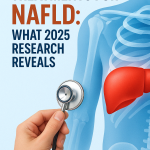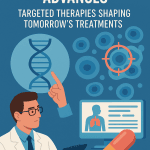Non-alcoholic fatty liver disease (NAFLD) has surged to the forefront of global health concerns, impacting over a billion people worldwide. As it silently progresses from simple fat accumulation to severe inflammation and fibrosis, NAFLD now ranks as the leading cause of chronic liver disease. But 2025 is shaping up to be a landmark year. Armed with groundbreaking research, clinicians are unveiling revolutionary strategies to reverse liver damage, slow progression, and transform patient outcomes.
Unlike past decades where treatment centered around lifestyle modification alone, today’s science reveals cutting-edge pharmaceuticals, gene therapies, nutraceuticals, and digital health tools reshaping how we combat fatty liver disease. This article dives deep into the top game-changing treatments for NAFLD revealed by 2025 research and what they mean for patients, doctors, and the future of liver health.
Understanding the Burden of NAFLD in 2025
NAFLD affects roughly 25–30% of the global adult population, with prevalence rising sharply among children and adolescents due to poor diet, sedentary lifestyles, and insulin resistance. The disease exists along a continuum:
- Simple steatosis: Excess fat in liver cells
- Non-alcoholic steatohepatitis (NASH): Fat + inflammation + liver cell damage
- Fibrosis: Scarring of liver tissue
- Cirrhosis: Permanent liver damage and risk of liver failure
NAFLD has no approved pharmaceutical treatment—until now. The 2025 research landscape has produced several promising therapies moving rapidly through clinical trials, and some have already received conditional regulatory approvals in select countries.
The Root of the Problem: Why NAFLD Has Been So Hard to Treat
NAFLD isn’t caused by one single mechanism. It involves insulin resistance, oxidative stress, mitochondrial dysfunction, gut microbiome imbalance, and genetic susceptibility. That complexity means treatments need to address multiple biological targets.
Until recently, most management strategies focused on:
- Weight loss through diet and exercise
- Managing type 2 diabetes and lipid disorders
- Liver enzyme monitoring
But in real life, lifestyle changes alone are not enough for many patients. The new wave of treatments aims to go beyond symptom management to disease reversal.
1. GLP-1 Receptor Agonists: A Game Changer in NAFLD and Obesity
Drugs originally designed for diabetes are now becoming powerful tools for liver disease. GLP-1 receptor agonists, such as semaglutide and tirzepatide, have emerged as top contenders for NAFLD treatment in 2025.
How they work:
- Mimic a natural gut hormone to increase insulin sensitivity
- Reduce appetite and promote satiety
- Induce weight loss
- Reduce liver fat and inflammation
Latest findings:
A 2025 multicenter Phase 3 trial of tirzepatide showed a 58% reduction in liver fat after 48 weeks, with NASH resolution in 36% of participants—a staggering result for a once-weekly injection.
Semaglutide has similarly shown improvements in liver enzymes, insulin resistance, and fibrosis markers. Patients also report significant weight loss and cardiovascular benefits.
GLP-1 agonists are now being tested in combination with other liver-specific agents for even stronger results.
2. PPAR Agonists: Targeting the Root of Fatty Liver
Peroxisome proliferator-activated receptors (PPARs) regulate genes involved in fat metabolism and inflammation. Several PPAR dual or pan agonists have reached advanced trial phases by 2025.
Lanifibranor, a pan-PPAR agonist, has shown ability to:
- Improve fibrosis
- Reduce liver inflammation
- Normalize liver enzyme levels
Recent trials revealed fibrosis improvement in over 45% of patients, with sustained results even after therapy discontinuation.
Other PPAR-based agents in 2025 trials:
- Elafibranor (PPARα/δ dual agonist)
- Saroglitazar (approved in India, undergoing global expansion)
- Seladelpar (PPARδ agonist for NASH and cholestatic liver disease)
These drugs act on multiple levels—lipid metabolism, glucose control, and inflammation—making them strong candidates for personalized treatment protocols.
3. FXR Agonists: Rewriting Bile Acid Metabolism
Farnesoid X receptors (FXRs) play a central role in bile acid homeostasis and fat metabolism. Obeticholic acid (OCA), the most studied FXR agonist, was the first drug to show improvements in liver fibrosis without worsening NASH.
In 2025, OCA continues to dominate trials, showing:
- Reduced liver stiffness
- Better glycemic control
- Improved HDL/LDL ratios
Though some patients experience pruritus (itching), modified FXR agonists are under development to reduce side effects while preserving efficacy.
Cilofexor and tropifexor, newer FXR agents, offer better tolerability and more potent anti-inflammatory actions. They’re especially promising when combined with GLP-1 or PPAR drugs.
4. FGF Analogues: Mimicking Natural Growth Factors
Fibroblast growth factors (FGFs) help regulate glucose and lipid metabolism. In 2025, FGF19 and FGF21 analogues are transforming liver treatment paradigms.
Pegbelfermin (FGF21 analogue) has been shown to:
- Reduce liver fat by up to 30%
- Improve markers of fibrosis
- Decrease fasting glucose and triglycerides
Aldafermin (FGF19 analogue) is another candidate that reduces bile acid synthesis and liver inflammation. Studies highlight its potential in slowing fibrosis progression and restoring metabolic flexibility.
FGFs are often used as adjunctive therapies alongside GLP-1s or statins, creating synergistic effects that target both the liver and metabolic syndrome.
5. Microbiome-Based Therapies: Gut-Liver Axis Breakthroughs
Emerging research in 2025 solidifies the gut-liver axis as a crucial component of NAFLD. Dysbiosis—imbalanced gut bacteria—contributes to endotoxin leakage, inflammation, and fat accumulation in the liver.
Innovative treatments include:
- Precision probiotics (engineered strains to reduce endotoxins)
- Fecal microbiota transplantation (FMT) with NAFLD-adapted donors
- Postbiotics (short-chain fatty acids, bile acid modulators)
- Polyphenol-rich prebiotics to reshape the gut environment
One 2025 study from the University of Helsinki showed that a specific probiotic blend reduced liver enzyme levels by 25% and liver fat by 18% in just 10 weeks.
These therapies hold immense promise for early-stage NAFLD and as adjuncts to pharmacotherapy.
6. Gene Editing and RNA Therapies: The Frontier of Personalized Medicine
Advanced techniques like CRISPR-Cas9, siRNA, and antisense oligonucleotides (ASOs) are now entering trials for genetically driven NAFLD.
Key targets in 2025 include:
- PNPLA3 gene (linked to fatty liver in Hispanic populations)
- TM6SF2 gene (involved in triglyceride export)
- SREBP-1c gene (regulator of fatty acid synthesis)
Inclisiran, a siRNA targeting PCSK9, shows dual benefits—lowering LDL cholesterol and indirectly improving liver markers. These RNA-based therapies represent high-precision tools tailored to genetic profiles, especially in cases resistant to standard treatment.
7. Nutraceuticals and Functional Foods: Natural Solutions Backed by Science
Patients increasingly seek natural remedies—and in 2025, many have been validated by clinical evidence.
Top liver-supportive compounds include:
- Berberine: Improves insulin resistance and liver enzymes
- Silymarin (milk thistle extract): Antioxidant and anti-fibrotic actions
- Curcumin: Reduces hepatic inflammation and oxidative stress
- Inositol: Shown to decrease liver fat in women with PCOS
- Green tea catechins: Improve liver enzymes and fat oxidation
- Astaxanthin: Potent mitochondrial antioxidant beneficial for fatty liver
Functional food companies now offer formulas that combine these nutrients, and several are undergoing pharmaceutical-grade trials.
8. Digital Health Tools and AI in NAFLD Management
In 2025, AI-powered apps and wearables help patients and doctors monitor liver health in real time. These tools offer:
- Continuous glucose monitoring and insulin resistance scoring
- Remote liver fat imaging through portable ultrasound
- AI-based diet tracking for glycemic load and nutrient density
- Personalized coaching based on behavior patterns and biomarkers
Digital therapeutics reduce the burden on healthcare systems and increase adherence to lifestyle modifications—the foundation of all NAFLD care.
The Rise of Combination Therapies: Tackling NAFLD From All Angles
Single-drug treatments may only improve one aspect of NAFLD. Combination therapies are now the gold standard in clinical trials.
Examples include:
- GLP-1 agonist + FXR agonist
- PPAR agonist + FGF analogue
- Metformin + natural compound blend
In 2025, over 30 major studies are testing multi-target strategies to reverse liver fat, reduce inflammation, and regenerate liver tissue simultaneously.
This integrative approach is the future of liver medicine.
FAQs
GLP-1 receptor agonists (like semaglutide and tirzepatide) are currently leading in efficacy and safety. However, combination therapies may soon outperform monotherapies.
As of 2025, some treatments have received conditional approvals or breakthrough designations for NASH with fibrosis. Full approvals are pending final trial results.
Yes, especially in early stages. Diet, weight loss, and exercise remain foundational. However, many patients benefit from medical therapies to accelerate recovery.
Several, like milk thistle, berberine, and curcumin, show real benefits in trials. Choose clinically tested formulas and consult your doctor.
Routine blood tests, liver enzyme checks, ultrasound, or FibroScan can detect fatty liver. Symptoms are often silent, so screening is essential if you’re overweight, diabetic, or have high cholesterol.








Post a comment